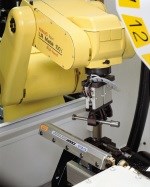Methods' Revamped Lineup Features Advanced Technology
“Smart” machine tools. Spindles reaching 60,000 rpm. Affordable robots for load/unload.
Share




Methods Machine Tools, Inc.“Smart” machine tools. Spindles reaching 60,000 rpm. Affordable robots for load/unload.
Not long ago, statements like these were used to characterize the next generation of machining technology. Today, in fact, these statements apply to machinery currently available, with many examples already in full operation on the floors of machine shops. These are machines “smart” enough to detect changing cutting conditions on a job and adapt accordingly. These are machines with spindle speeds reaching 60,000 rpm on a routine basis. These are machines equipped with economical and reliable robots able to load and unload huge production batches.
In November, machine tool supplier Methods Machine Tools (Sudbury, Massachusetts) took advantage of the transition to a new century by opening up its National Technical Center near Boston to shop managers from New England and across the country. At the week-long show, engineers from Methods and its partner companies displayed working demonstrations of the latest generation of machine tool technology that is making its way onto shop floors.
For example, integrated robotic systems to enhance drilling and milling applications attracted great interest, reports John Crean, product manager for the Fanuc RoboDrill line. He noted that fast spindle speeds aren’t much help to a machine shop if it doesn’t have the manpower to load parts for three shifts and over weekends. Shop managers are well aware that today’s limited workforce should not be a factor in production output, he says.
The solution is to be able to integrate any machine tool with a variety of load/unload options, and Methods showed several examples of this approach. Various demonstrations centered around Fanuc’s line of high-speed drilling centers, where an 8,000 or 15,000 rpm spindle can be combined with a variety of bed configurations and integrated pallet-shuttle and robotic systems designed specifically for use with the machine. With one-second tool changes and artificial intelligence built into the control, a machine shop is able to maintain unmanned operations and reach new levels of production speed and efficiency.
Milling keeps getting faster, too. Incredibly fast milling speeds are continually being obtained in the laboratory, but Matsuura Corp. has developed a 60,000 rpm machine tool that’s already at work on production floors. The newly introduced LX-1 was developed by the builder as a high acc/dec machining center that is specifically designed for small, precise parts cutting. With a 3,545 ipm rapid traverse rate and an 1,181 ipm actual cutting feed rate provided by linear motor technology, the LX-1 is well-suited for small die and mold work for plastic injections, EDM electrodes and forging parts. The acc/dec rate is 1.5G. The 18-pocket tool changer is expandable to 30 tools.
Comparable strides in technology were demonstrated by Methods EDM Division. Although EDM has enjoyed great gains over the years, there still are conditions that can bog down even the most advanced wire EDM machine, says Charlie Quillen, EDM Division product manager. Most common is wire breakage due to changes in workpiece thickness, which can cause the machine to supply an excess of cutting current, creating an unstable discharge.
Most current-generation EDM controls adjust the cutting current to match the thick part of the workpiece about to be cut, often resulting in wire breakage in thinner areas during the cutting operation. While automatic wire re-threading may keep the operation going, this condition makes it impossible to achieve the most efficient cutting speed for the project, Mr. Quillen explains.
The solution on display was an adaptive control function developed by Fanuc Ltd. for its line of submerged wire EDM machines. This feature allows for great improvements in accuracy even when the workpiece thickness varies or an interrupted cut creates an unstable discharge. With the adaptive control, the thickness of the workpiece is monitored in real-time, and the discharge current density can be controlled at a constant level. The most suitable cutting current with the best efficiency is supplied in each thickness automatically. This allows for a higher cutting speed, energy savings, and constant kerf width that produces more accurate parts.
This feature is available on Fanuc’s recently introduced “I” series of submerged wire EDM machines.
Related Content
Quick-Change Tool Heads Reduce Setup on Swiss-Type Turning Centers
This new quick-change tooling system enables shops to get more production from their Swiss turning centers through reduced tool setup time and matches the performance of a solid tool.
Read More6 Machine Shop Essentials to Stay Competitive
If you want to streamline production and be competitive in the industry, you will need far more than a standard three-axis CNC mill or two-axis CNC lathe and a few measuring tools.
Read MoreHow to Determine the Currently Active Work Offset Number
Determining the currently active work offset number is practical when the program zero point is changing between workpieces in a production run.
Read MoreHigh RPM Spindles: 5 Advantages for 5-axis CNC Machines
Explore five crucial ways equipping 5-axis CNC machines with Air Turbine Spindles® can achieve the speeds necessary to overcome manufacturing challenges.
Read MoreRead Next
Registration Now Open for the Precision Machining Technology Show (PMTS) 2025
The precision machining industry’s premier event returns to Cleveland, OH, April 1-3.
Read More5 Rules of Thumb for Buying CNC Machine Tools
Use these tips to carefully plan your machine tool purchases and to avoid regretting your decision later.
Read MoreSetting Up the Building Blocks for a Digital Factory
Woodward Inc. spent over a year developing an API to connect machines to its digital factory. Caron Engineering’s MiConnect has cut most of this process while also granting the shop greater access to machine information.
Read More
































.jpg;maxWidth=970;quality=90)